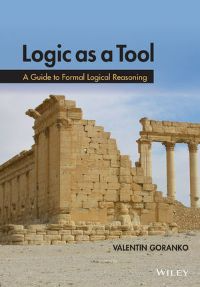Logic as a Tool a Guide to Formal Logical Reasoning
Material type: TextLanguage: English Publication details: Chichester : Wiley, c2016Description: xxii, 358 p. : illISBN:
TextLanguage: English Publication details: Chichester : Wiley, c2016Description: xxii, 358 p. : illISBN: - 9781118880005
- 511.3 GOR
| Item type | Current library | Collection | Shelving location | Call number | Copy number | Status | Date due | Barcode |
|---|---|---|---|---|---|---|---|---|
 Reference Collection
Reference Collection
|
TIEST (Thar) Library | Engr Abul Kalam Library | Computer Science & Information Technology - Thar Institute | 511.3 GOR | 2023-24 | Available | 98609 |
Valentin Goranko
is an associate professor at the Department of Applied Mathematics and Computer Science of the Technical University of Denmark. He has had over 25 years of University teaching and research experience: in particular, he has taught several courses partly based on the proposed book.
SUMMARY
The book explains the grammar, semantics and use of classical logical languages and teaches the reader how grasp the meaning and translate them to and from natural language. It illustrates with extensive examples the use of the most popular deductive systems -- axiomatic systems, semantic tableaux, natural deduction, and resolution -- for formalising and automating logical reasoning both on propositional and on first-order level, and provides the reader with technical skills needed for practical derivations in them. Systematic guidelines are offered on how to perform logically correct and well-structured reasoning using these deductive systems and the reasoning techniques that they employ.
Concise and systematic exposition, with semi-formal but rigorous treatment of the minimum necessary theory, amply illustrated with examples
Emphasis both on conceptual understanding and on developing practical skills
Solid and balanced coverage of syntactic, semantic, and deductive aspects of logic
Includes extensive sets of exercises, many of them provided with solutions or answers
Supplemented by a website including detailed slides, additional exercises and solutions
For more information browse the book's website at: https://logicasatool.wordpress.com
